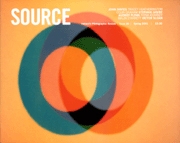Relentless Landscapes
'Too Dark for Night' by Clare Langan was at Green on Red Gallery, Dublin, 9th February - 3rd March 2001, Vedanta Gallery, Chicago, 23rd March - 24th May 2001
Review by Niamh Ann Kelly
Issue 26 Spring 2001
View Contents ▸
"The desert was so huge, and the horizons so distant, that they make a person feel small, and as if he should remain silent the wind never stopped."
In her exhibition Too Dark for Night, at the Green on Red Gallery, Dublin, Clare Langan has mounted an exhibition that seeks to explore the nature of the desert, in a way that seems to mirror Coehlo's description' The exhibition features a short film and a series of photographic prints, stills from the film. It is the display of these prints, though they are individually of merit, which provides the only weak link in this presentation as they are viewed en route to the film and serve in that context to reduce the potential impact of the main work.
Primarily an artist working in photography and film, Langan has sought to push the potential of both through an innovative interplay between them. This current show follows, in broad theme, on her last solo exhibition at the same venue, Forty Below. While that project explored ice/water as a grand theme of the natural world, the current exhibition Too Dark for Night is concerned with the desert - sand and wind - as a primary elemental force. The film seeks to construct an experience of the desert through a symbiosis of image and sound. Shot in the Namib Desert in Namibia, this ten-minute work presents an extraordinary experience. The film seeks to explore a traditional theme of art, that of the force of nature and the relative insignificance of humankind in its path, it also presents a refreshingly distinctive, re-vitalization of both a medium and a process of art practice.
The visual content of the film portrays the desert's natural reclamation of a town. Sand permeates, by force of the prevailing wind, man's constructed living and working space. The film is presented in three distinct phases. Firstly, there is a situating of the viewer in what is clearly a post-apocalyptic landscape; a lone figure wanders amid dark barren trees in a vast desert plain. The middle phase of the film follows this solitary figure moving purposelessly through the immense desert and develops into a series of frames outlining the devastating cumulative effect as sand fills the interior of a human habitation. This sequence is overtly classical in formula and adds an art-historical resonance to the work - there are blatantly staged still-life tableaux. The final set of frames returns the viewer once again to striking imagery of vastness, with the sole anonymous human protagonist presenting a mere speck on the plain of the desert. Too Dark for Night ends with astounding closure, defined by a remarkable marrying of sound and image.
The film fluctuates between ochre hues and black and white sequences, respectively symbolic of the disparity between actual experience and its remembrance. In many instances it is as though the sand and the driving wind are the only moving elements in the film, seeming to glide through the images. The considered visual impact of each frame seems to direct the structure of the work, and in that sense Langan has reversed the typical emphasis in film work, where content often seeks to direct the visual and aural form. Her chosen structural device is apt for the overall theme of the work: the overwhelming power of nature, which is itself guided by its own previous impact rather than fitting a delineated scheme.
Though Langan's oeuvre is typically romantic in an art-historical sense, it is probably more relevant in a contemporary setting than this term connotes, both in terms of its thematic content and its chosen medium. While the thrust of the work reflects and inspires an awe of nature that relates it to the main concern of traditional romanticism, it does so in such a fresh and contemporary manner as to effectively re- specify what is romantic and reposition notions of the sublime as a significant force in contemporary life. The strength of the work lies in its, albeit narrow, escape from chocolate-box sentimentality as defined by recent filmic efforts in the mainstream (such as The English Patient) at describing the desert on screen. Effectively renegotiatlng the assumption that narrative is structurally central to film work, it is the contemplative aspect which transcends the sequence of visuals in this film that sets the work apart. The fact that Langan has worked predominantly as a photographer has resulted in the work presenting a quality not often enough witnessed in film work, namely artistry.
Other articles by Niamh Ann Kelly:
Other articles mentioning Clare Langan:
Other articles on photography from the 'Landscape' category ▸






